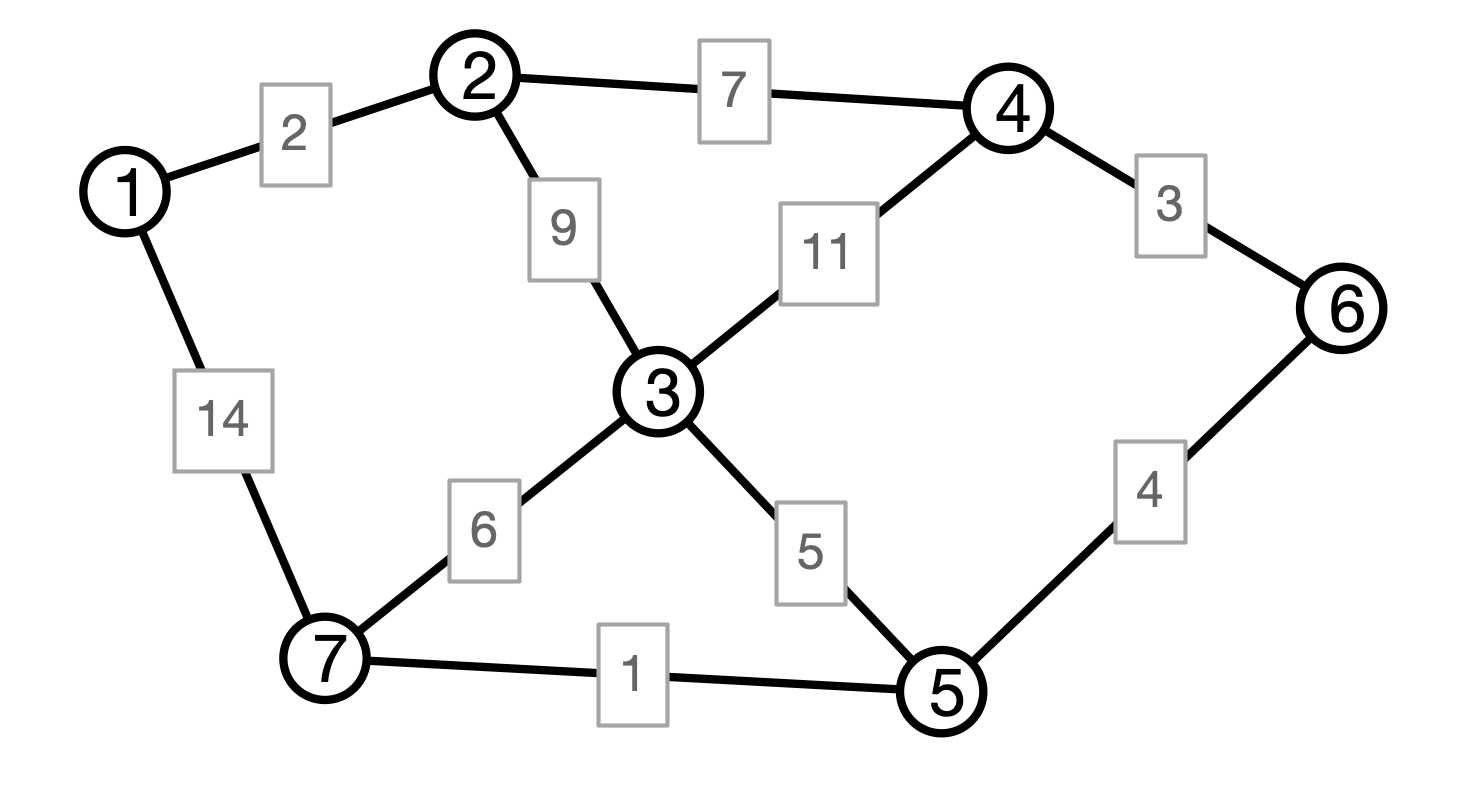Lecture 19: Minimum Spanning Trees, Part 2
COSC 311 Algorithms, Fall 2022
$ \def\compare{ {\mathrm{compare}} } \def\swap{ {\mathrm{swap}} } \def\sort{ {\mathrm{sort}} } \def\insert{ {\mathrm{insert}} } \def\true{ {\mathrm{true}} } \def\false{ {\mathrm{false}} } \def\BubbleSort{ {\mathrm{BubbleSort}} } \def\SelectionSort{ {\mathrm{SelectionSort}} } \def\Merge{ {\mathrm{Merge}} } \def\MergeSort{ {\mathrm{MergeSort}} } \def\QuickSort{ {\mathrm{QuickSort}} } \def\Split{ {\mathrm{Split}} } \def\Multiply{ {\mathrm{Multiply}} } \def\Add{ {\mathrm{Add}} } \def\cur{ {\mathrm{cur}} } \def\gets{ {\leftarrow} } $
Overview
- Midterm Comments
- Prim’s Algorithm, Again
- Kruskal’s Algorithm
Overall Midterm Comments
- Interpretation of grades
- Very happy with grade distribution
- Two more consistent issues
- Question 2 ($0$, $\Theta$, $\Omega$)
- Question 3 (D&C Algorithm)
Question 3 Illustration
MSTs
Input:
- a weighted graph $G = (V, E)$ with edge weights $w$
Output:
-
a set $F$ of edges in $E$ such that
- $(V, F)$ is connected
- sum of weights of edges in $F$ is minimal among all connected sub-graphs of $G$
The graph $T = (V, F)$ is called a minimum spanning tree of $G$
Prim’s Algorithm
PrimMST(V, E):
initialize set S = {v} with v arbitrary
initialize set F = {} of MST edges, priority queue Q
for each neighbor x of v
add (v, x) to Q with priority w(v, x)
while Q is not empty
(u, v) <- removeMin(Q)
if S doesn't contain v
add (u, v) to F
for each neighbor x of v
add (v, x) to Q with priority w(v, x)
return (S, F)
Prim Illustration

Cuts in Graphs
Definition. Let $G = (V, E)$ be a graph. A cut in $G$ is a partition of $V$ into two (non-empty) subsets $U$ and $V - U$.

Cuts and MSTs
Cut Claim. Suppose:
- $G = (V, E)$ is a weighted graph (with distinct edge weights)
- $U, V - U$ a cut in $G$
- $T = (V, F)$ an MST
- $e = (u, v)$ is the minimum weight edge that crosses the cut
- $u \in U$ and $v \in V - U$
Then:
- $T$ contains the edge $e$
Cut Claim Illustration

Prim, Again
PrimMST(V, E):
initialize set S = {v} with v arbitrary
initialize set F = {} of MST edges, priority queue Q
for each neighbor x of v
add (v, x) to Q with priority w(v, x)
while Q is not empty
(u, v) <- removeMin(Q)
if S doesn't contain v
add (u, v) to F
for each neighbor x of v
add (v, x) to Q with priority w(v, x)
return (S, F)
Prim Correctness I
Cut claim $\implies$ Prim produces an MST.
Why?
Consider $k$th edge $e_k$ added by Prim
- $S_k = $ contents of $S$ before edge added
What can we say about the cut $S_k, V - S_k$?
Prim Correctness II
First Conclusion. Every edge $e$ added by Prim’s algorithm is in the MST.
Still to show. All MST edges are added.
Why is this so?
- Suffices to argue that Prim produces a spanning tree
- Set of edges found by Prim form a tree
- All vertices of $V$ are in tree (if $G$ is connected)
Conclusion. Prim’s algorithm produces an MST.
Prim Running Time?
PrimMST(V, E):
initialize set S = {v} with v arbitrary
initialize set F = {} of MST edges, priority queue Q
for each neighbor x of v
add (v, x) to Q with priority w(v, x)
while Q is not empty
(u, v) <- removeMin(Q)
if S doesn't contain v
add (u, v) to F
for each neighbor x of v
add (v, x) to Q with priority w(v, x)
return (S, F)
Conclusion
Prim’s algorithm:
- computes an MST in $G$
- if efficient priority queue is used, running time is $O(m \log n)$
Prim’s algorithm is greedy
- to grow a tree, always add the lightest outgoing edge
MSTs, Another Way
Prim:
- Grow tree greedily from a single seed vertex
- Maintain a (connected) tree
Edge Centric View:
- Maintain a collection of edges (not necessarily a tree)
- Add edges to collection to eventually build an MST
Questions:
- How to prioritize edges?
- How to determine whether or not to include an edge?
Picture

Kruskal’s Algorithm
Kruskal(V, E, w):
C <- collection of components
initially, each vertex is own component
F <- empty collection
# iterate in order of increasing weight
for each edge e = (u, v) in E
if u and v are in different components then
add (u, v) to F
merge components containing u and v
endif
endfor
return F
Kruskal Illustration

Kruskal Correctness I
Claim 1. Every edge added by Kruskal must be in every MST.
Why?
- Suppose $e = (u, v)$ added by Kruskal
- Consider the cut $U, V - U$ where $U$ is $u$’s component
- $e$ is lightest edge across the cut (why?)
- therefore $e$ must be in MST (why?)
Kruskal Correctness II
Claim 2. Kruskal produces a spanning tree.
Why?
-
edges added by Kruskal do not contain cycles (why?)
-
edges edges added by Kruskal connect graph (why?)
Conclusion
Theorem. Kruskal’s algorithm produces an MST.
Question. How could we implement Kruskal’s algorithm efficiently? What is its running time?
Next Time
- Efficiency of Kruskal
- Interval Scheduling